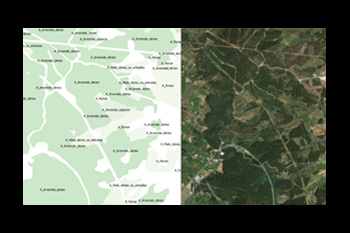Automatic detection of permanent green areas
Summary
The Army Geospatial Information Center (CIGeoE) cartographs the national territory through the telestresing of objects from aerial photographs, with subsequent validation on the ground, by photogrammetry operators qualified for this purpose. A process that is too time-consuming, which can affect the gap between the army's charters, in relation to the observed reality.
For this study, within a limited area, two main classification methodologies were implemented, developing for this purpose three classifiers with excellent results, namely XGBoost, Random Forest and Support Vector Machines, using different classification approaches. One of the methodologies implemented involves a Sentinel-1 and 2 product of the same date as the original classification or with a very small time difference and another methodology that involves the use of time series with features for the classification, maintaining all the necessary standards ensuring that the acquired objects have the same degree of detail and accuracy. For the scope of this project, the semi-automatic detection of permanent vegetation (8 main classes) was chosen.
The algorithm developed presented very satisfactory results in the study regions, constituting a very important step in the automation of the automatic classification of vegetation in Portugal. With the implementation of this algorithm in the CIGeoE Production Chain, the entire process of acquiring and classifying vegetation will be much faster, thus contributing to the reduction of the time lag between aerial photographs and the availability of information to users.
Motivation and Context
CIGeoE provides with geospatial information the Army and other entities, as well as develops scientific and technological research actions. To constitute as a national reference of excellence in the provision of geographical information, in particular in the production of the Military Charter of Portugal, in the scale 1:25 000 the Base Charter of Portugal. The production of geospatial information of the Military Charter is based on a global acquisition of real-world objects, one of the themes being vegetation, acquired through aerial photography and later interpreted and vectorized manually by photogrammetry operators that classify the desired geographic information according to the Acquisition Standards, in a process called restitution[1].
Due to the large volume of information to be processed manually by operators, and the fact that this information is validated on the ground in the face of the time lag between aerial photographs and fieldwork, this process is characterized as being quite time consuming and demanding.
It is intended, with the elaboration of this project, the development of tools that, using machine learning algorithms, allow the automatic classification of permanent vegetation, from multispectral images of Sentinel, according to the CiGeoE Acquisition Standards. The inclusion of this process in the production chain of the Military Charter aims to allow a drastic reduction in data acquisition time, as well as a greater degree of updating in relation to validation data from field work.
Permanent vegetation is defined according to these standards, whether natural or cultivated, which maintains its vegetation area during the change of seasons, without the presence of external factors that can considerably affect its size (fires, deforestation, etc.). Their characteristics may be slightly influenced over time, but overall they will remain relatively consistent throughout the year. These characteristics make this type of vegetation relevant for cartographic cataloging.
[1] These standards are confidential, and consequently restricted access, and are made available to me for ancillary purpose in the construction of an efficient methodology


